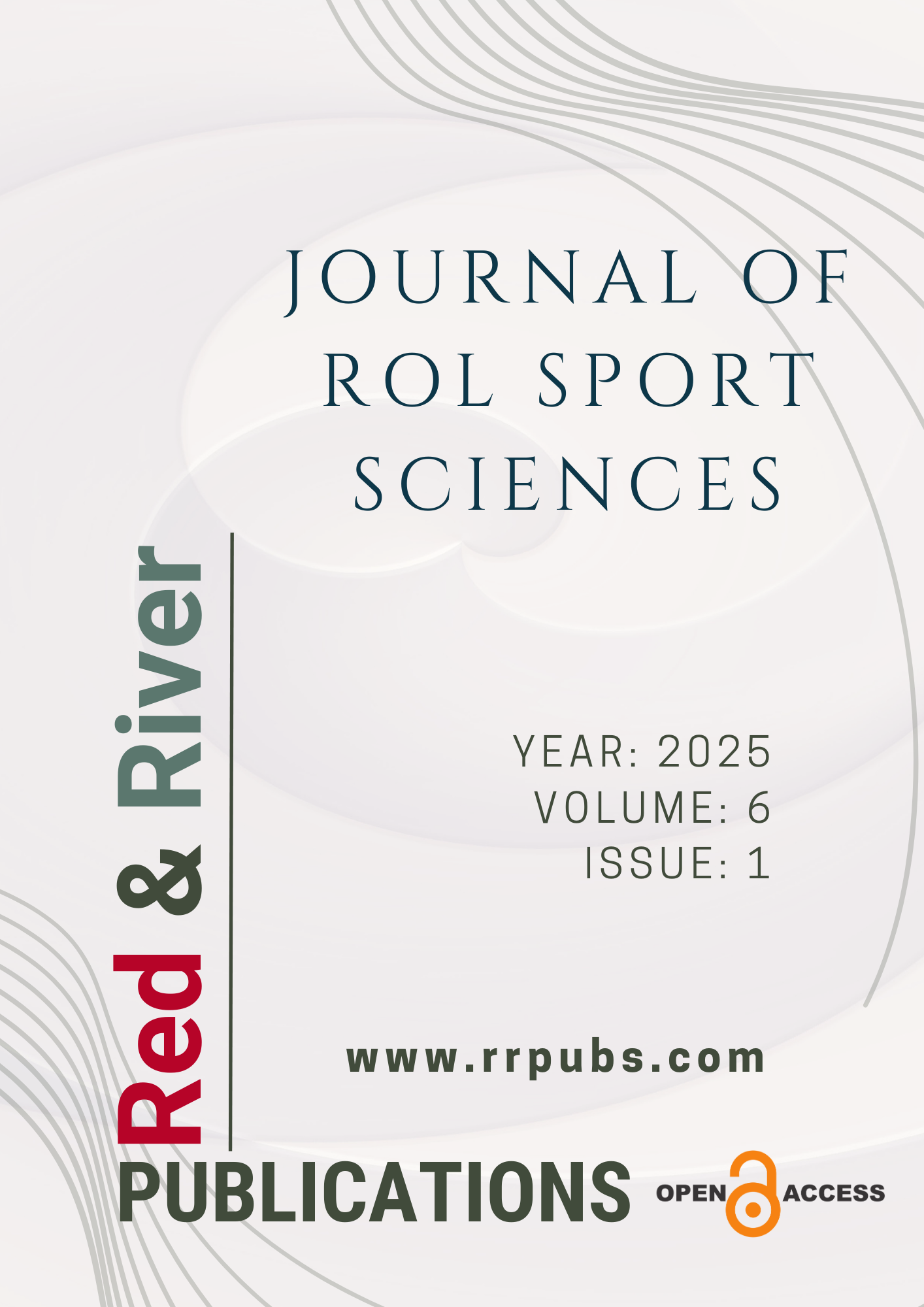Genç futbolcu transferi ve göçü: Umuda yolculuk mu, emek sömürüsü mü?
DOI:
https://doi.org/10.70736/jrolss.527Anahtar Kelimeler:
Emek sömürüsü, futbol, futbolcu göçü, göç, transferÖzet
Günümüzde, genç futbolcuların transfer süreçleri, önemli sorun olarak karşılaşılmaktadır. Bu bağlamda, futbolcuların transfer olduklarında karşılaştıkları zorluklar, umuda yolculuk ile emek sömürüsü arasındaki gerilim üzerinden şekillenmektedir. Mevcut çalışmada bu iki kavram üzerinden futbolcuların transfer süreçlerine odaklanılmıştır. Bu bağlamda çalışmanın amacı, genç futbolcuların transfer süreçlerini sosyo-ekonomik bir çerçevede ele alarak, bu sürecin ‘umuda yolculuk’ mu ‘emek sömürüsü’ mü olduğu sorusuna yanıt aramaktır. Çalışmada, özellikle Afrikalı futbolcuların Avrupa liglerine transfer süreçleri incelenerek, futbolcu göçünün ekonomik, sosyal ve kültürel dinamikleri değerlendirilmektedir. Araştırmada, Transfermarkt.de web sitesinden 1995 - 2024 yılları arasında gerçekleşen transfer verileri toplanmış ve bu veriler betimsel istatistik analizi yöntemiyle değerlendirilmiştir. Çalışmada nicel araştırma yöntemi kullanılmış ve betimsel istatistik analizi yöntemi ile futbolcu transferleri; transfer ücreti, oyuncu ulusu ve transfer yapılan ligler açısından kategorize edilerek analiz edilmiştir. Bulgular, Afrikalı futbolcuların düşük maliyetlerle veya bonservissiz şekilde Avrupa’ya transfer edildiğini ve bu durumun Avrupa’nın büyük ligleri için ekonomik avantaj yarattığını göstermektedir. Ayrıca, literatürdeki tartışmalara değinilmiş ve transfer sürecinin, bir yandan emek sömürüsüne, diğer yandan futbolcuların hayallerini gerçekleştirme çabalarına dönüşen “umuda yolculuk” durumu netleşmiştir. Bu çerçevede, Sonuç bölümünde, transfer süreçlerinin olumsuz etkilerini gözler önüne seren bulgulara yer verilmiş, aynı zamanda sorunların çözülmesi adına öneriler geliştirilmiştir. Yerel liglerin cazip hale getirilmesi, maaş artışlarının sağlanması, UEFA ve FIFA’nın uluslararası genç futbolcu transferlerini sınırlamaya yönelik etkili tedbirler alması gerektiği vurgulanmıştır. Ayrıca, futbolcu alım sürecinin yalnızca ekonomik kriterlerle değil, sosyo-tarihsel dinamiklerle de ele alınması gerektiği, bu alanda yapılacak araştırmaların faydalı olacağı ifade edilmiştir.
Referanslar
Acheampong, E. Y., & Malek, B. (2019). African footballers’ life cycles according to the analysis of transfer value along their career path: A case study of Ghanaian players. Sport in Society, 22(12), 2024–2044.
Berlinschi, R., Schokkaert, J., & Swinnen, J. (2013). When drains and gains coincide: migration and international football performance. Labour Economics, 21, 1-14.
Boadway, R. (2004). The theory and practice of equalization. CESifo Economic Studies, 50(1), 211-254.
Boer, W. (2004). A story of heroes, of epics: The rise of football in Nigeria. G. Armstrong, R. Giulianotti (Ed.), Football in Africa: Conflict, conciliation and community içinde (59-79. ss). Palgrave Macmillan London.
Chiweshe, M. K. (2014). The problem with African football: Corruption and the (under) development of the game on the continent. African Sports Law and Business Bulletin, 2(8).
Corbin, J., & Strauss, A. (2014). Basics of qualitative research: Techniques and procedures for developing grounded theory. Sage publications.
Dalziel, M., Downward, P., Parrish, R., Pearson, G., & Semens, A. (2013). Study on the assessment of UEFA’s home-grown player rule. The University of Liverpool and Edge Hill University.
Darby, P., Esson, J., & Ungruhe, C. (2024). Women’s transnational migration through football: Possibilities, responsibilities, and respectability in ghana. International Review for the Sociology of Sport, 59(5), 747-765
Elliott, R. (2012). Football and international relations: People, places, power. In Football: Politics of the global game, Warsaw, Poland, 1 June 2012
Esson, J. (2015). Escape to victory: Development, youth entrepreneurship and the migration of ghanaian footballers. Geoforum, 64, 47-55.
Europa, (2024). Annual inflation rates. Erişim adresi https://ec.europa.eu/eurostat/web/products-euro-indicators/w/2-18122024-ap. Erişim tarihi: 27.12.2024
Fair, L. (1997). Kickin’it: Leisure, politics and football in colonial Zanzibar, 1900s–1950s. Africa: Journal of the International African Institute, 67(2), 224-251.
Feess, E., & Muehlheusser, G. (2003). Transfer fee regulations in European football. European Economic Review, 47(4), 645-668.
Kovač, U. (2022). The precarity of masculinity: Football, pentecostalism, and transnational aspirations in Cameroon. Berghahn Books.
Lago‐Peñas, C., Peñas, S. L., & Lago, I. (2019). Player migration and soccer performance. Frontiers in Psychology, 10, 616.
Lally, A., Smith, M., & Parry, K. D. (2022). Exploring migration experiences of foreign footballers to England through the use of autobiographies. Soccer & Society, 23(6), 529-544.
Maguire, J., & Falcous, M. (2011). Sport and migration: Borders, boundaries and crossings. Routledge.
Ó’Conaill, S. (2018). Sustainable financing in football and the EU. In Research Handbook on EU Sports Law and Policy (pp. 246-260). Edward Elgar Publishing.
Okwechime, I., & Adetiloye, O. A. (2019). In search of “greener pitches”: African footballers and labor market migration in European football. World Review of Political Economy, 10(3), 377-405.
Oonk, G. (2021). Who may represent the country? Football, citizenship, migration, and national identity at the FIFA World Cup. The International Journal of the History of Sport, 37(11), 1046-1065.
Poli, R. (2010). Understanding globalization through football: The new international division of labour, migratory channels and transnational trade circuits. International Review for the Sociology of Sport, 45(4), 491-506.
Poli, R. (2013). Africans’ status in the European football players’ labour market. In Fringe nations in world soccer (pp. 122-135). Routledge.
Relvas, H., Littlewood, M., Nesti, M., Gilbourne, D., & Richardson, D. (2010). Organizational structures and working practices in elite European professional football clubs: Understanding the relationship between youth and professional domains. European Sport Management Quarterly, 10(2), 165-187.
Richardson, D., Littlewood, M., Nesti, M., & Benstead, L. (2012). An examination of the migratory transition of elite young European soccer players to the English Premier League. Journal of Sports Sciences, 30(15), 1605-1618.
Rohde, M., & Breuer, C. (2016). Europe’s elite football: Financial growth, sporting success, transfer investment, and private majority investors. International Journal of Financial Studies, 4(2), 12.
Scherrens, J. (2007). The muscle drain of African football players to Europe: trade or trafficking? (Doctoral dissertation).University of Graz, Austria.
Silk, M. L., & Andrews, D. L. (2012). Sport and neoliberalism: Politics, consumption, and culture. Temple University Press.
Storey, D. (2024). Footballing journeys: Migration, citizenship and national identity. Journal of Geography in Higher Education, 48(1), 22-30.
Transfermarkt.de, (2024). En pahalı transferler. Erişim adresi https://www.transfermarkt.com.tr/statistik/transferrekorde. Erişim tarihi: 17.09.2024
Walters, G., & Rossi, G. (2009). Labour market migration in European football: Key issues and challenges. Conference proceedings from the feet-drain conference hosted by the Birkbeck Sport Business Centre in May 2008.
Yiğit, E., & Şişman, M. (2019). Neoliberal dönemde uluslararası futbolcu hareketliliği. Spor ve Performans Araştırmaları Dergisi, 10(1), 81-93.
İndir
Yayınlanmış
Nasıl Atıf Yapılır
Sayı
Bölüm
Lisans
Telif Hakkı (c) 2025 ROL Spor Bilimleri Dergisi

Bu çalışma Creative Commons Attribution 4.0 International License ile lisanslanmıştır.

